stop start AUDI Q7 2014 Owner´s Manual
[x] Cancel search | Manufacturer: AUDI, Model Year: 2014, Model line: Q7, Model: AUDI Q7 2014Pages: 340, PDF Size: 85.02 MB
Page 235 of 340
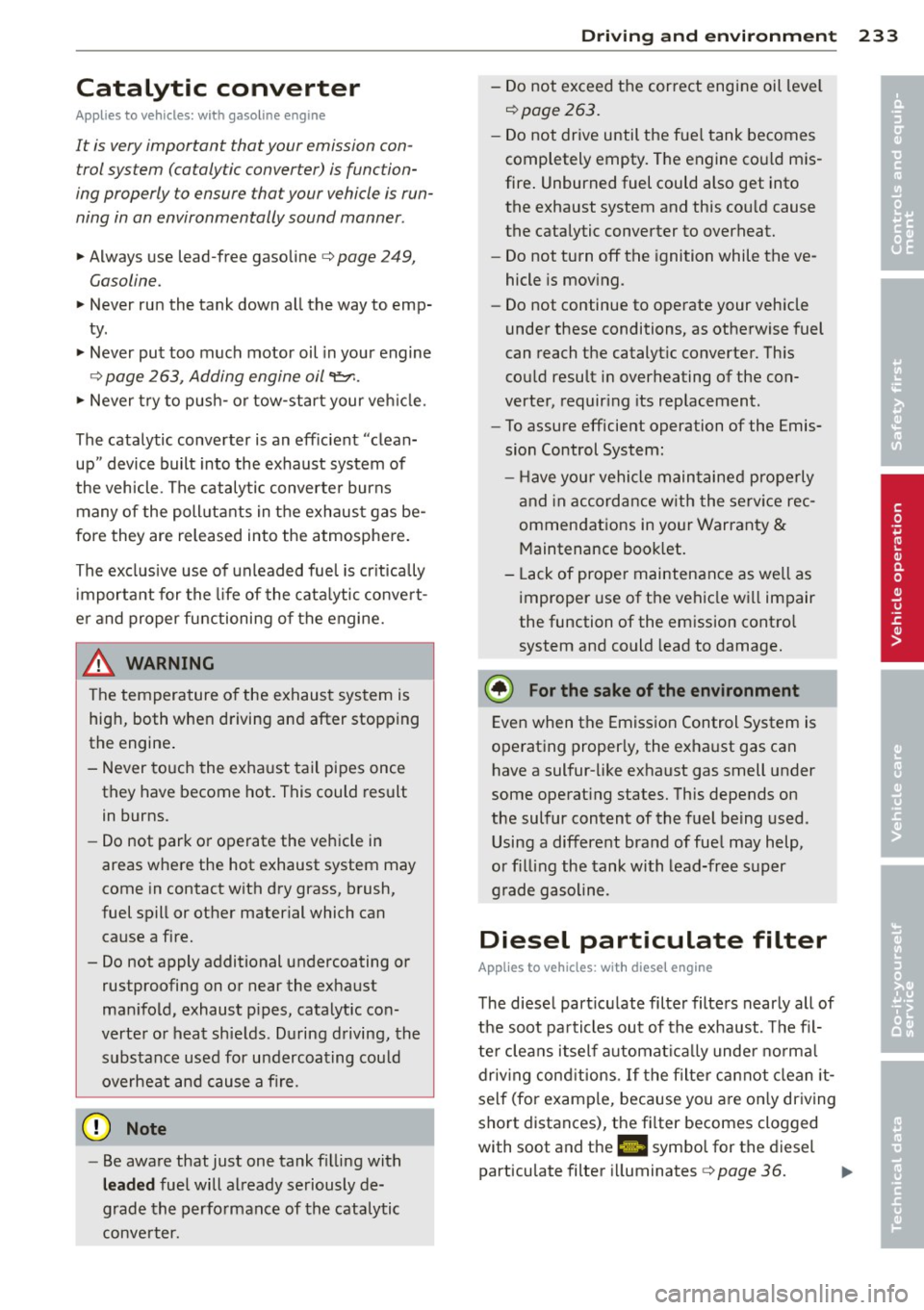
Catalytic converter
Applies to vehicles: with gasoline engine
It is very important that your emission con
trol system (catalytic converter) is function
ing properly to ensure that your vehicle is run
ning in an environmentally sound manner .
... Always use lead-free gasoline c::> page 249,
Gasoline .
... Never run the tank down all the way to emp
ty .
... Never put too much motor oil in your engine
c::> page 263, Adding engine oil 't=r..
.,. Never try to push-or tow-start your veh icle.
The catalytic converter is an eff icient "clean
up" device built into the exhaust system of
the vehicle. The catalytic converter burns
many of the pollutants in the exhaust gas be
fore they are released into the atmosphere.
The exclus ive use of unleaded fuel is cr it ically
i mportant for the life of the cata lytic convert
e r and proper functioning of the engine.
& WARNING ,~
T he temperature of the exhaust system is
high, both when driving and after stopping
the engine .
- Never touch the exha ust tail pipes once
they have become hot. This could result
in burns.
- Do not park or operate the vehicle in
areas where the hot exhaust system may
come in contact with dry grass, brush,
fuel spill or other material which can
cause a fire.
- Do not apply additional undercoating or
rustproofing on or near the exhaust
manifold, exhaust p ipes, catalytic con
verter or heat shields . During driving, the
substance used for undercoating cou ld
overheat and cause a fire.
(D Note
- Be aware that just one tank f illing with
leaded fuel will already seriously de-
grade the performance of the catalytic
conve rter.
Dri vin g and en vironm ent 233
-Do not exceed the correct engine oil level
c::> page 263.
- Do not drive until the fue l tank becomes
completely empty. The engine cou ld mis
fire. Unburned fuel could also get into
the exhaust system and this cou ld cause
the catalytic converter to overheat.
- Do not turn off the ignition while the ve
hicle is mov ing.
- Do not continue to operate your veh icle
under these conditions, as otherwise fuel
can reach the catalyt ic converter. Th is
cou ld result in overheating of the con
verter, requir ing its replacement.
- To assure efficient operation of the Emis
sion Control System:
- Have you r vehicle main tained properly
and in accordance w ith the se rv ice rec
ommendations in your Warranty & Maintenance book let.
- Lack of proper maintenance as we ll as
improper use of t he vehicle will impair
the function of the emission contro l
system and could lead to damage.
@) For the sa ke of the env ironment
Even when the Emission Control System is
operating properly, the exhaust gas can have a sulfur-like exhaust gas smell under
some operat ing states. This depends on
the sulfur content of the fuel being used .
Using a different brand of fuel may help,
or filling the tank with lead-free s uper
g rade gasoline.
Diesel particulate filter
App lies to vehicles: wit h diese l eng ine
The diesel part iculate filter filters nearly all of
the soot pa rticles out of the exhaust . T he fil
te r clea ns itself automat ica lly under no rma l
driv ing cond itions. If the filter cannot clean it
self (for example, because you are on ly driving
short distances), the fi lter becomes clogged
with soot and the
Ill symbo l for the diesel
particulate filter i lluminates
c::> page 36. ..,_
•
•
Page 244 of 340
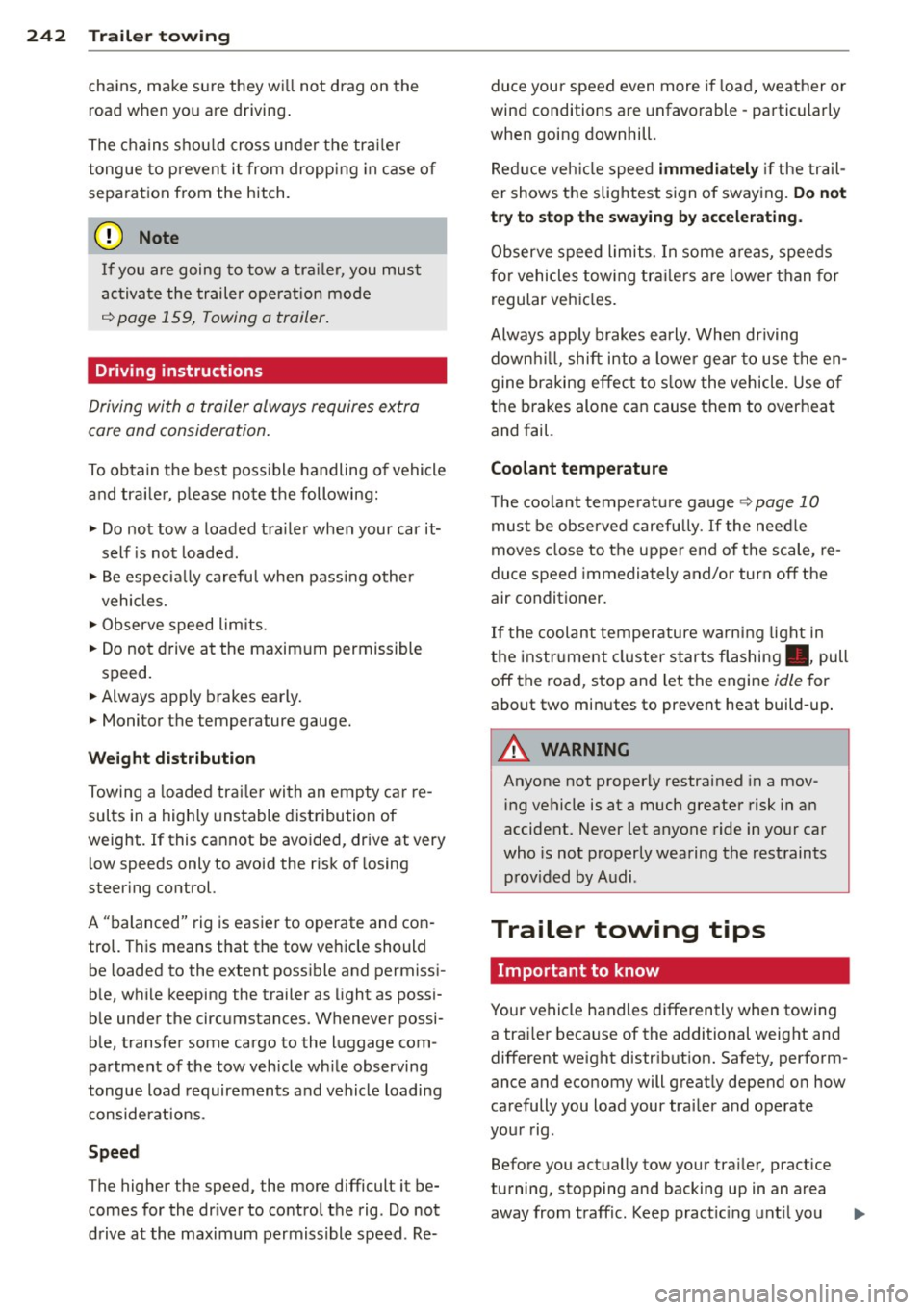
24 2 Trailer towing
chains, make sure they wi ll not drag on the
road when you are driving .
The cha ins shou ld cross under the tra ile r
tongue to prevent it from dropping in case of
separation from the hitch.
0 Note
If you are going to tow a tra ile r, you must
activa te the trailer operation mode
~ page 159, Towing a trailer.
Driving instructions
Driving with a trailer always requires extra
cor e and consid eration.
To obta in the best poss ible handling of vehicle
and tra ile r, p le ase no te the following:
.. Do not tow a loaded tra iler when your car it
self is not loaded.
.,. Be especia lly careful when pass ing othe r
vehicles .
.. Observe speed limits.
.. Do not driv e at the maximum p ermissible
speed.
.. Always apply brakes early.
.. Monitor the temperature gauge.
Weight di stributio n
Towing a loaded trai ler with an empty ca r re
sults in a high ly unstable distribution of
weight . If this cannot be avoided, drive at very
l ow speeds only to avoid the risk of los ing
steering control.
A "balanced" rig is eas ier to operate and con
trol. This means that the tow vehicle should
be loaded to the extent possible and permiss i
ble, while keeping the trailer as light as possi
b le under the circumstances. Whenever possi
b le, transfer some cargo to the luggage com
pa rtment of the tow veh icle wh ile observing
tongue load requirements and vehicle loading
considerations .
Speed
The higher the speed, the more difficult it be
comes for the driver to control the rig . Do not
drive at the maximum permiss ible speed . Re- duce your speed even more i
f load, weather or
wind conditions are unfavorable - particularly
when going downhill.
Red uce veh icle speed
immediately if the trail
er shows the slightest s ign of sway ing.
Do not
t ry to stop the swa ying by acceleratin g.
Observe speed limits. In some a reas, speeds
f or vehicles tow ing tra ile rs are lower than for
r egular vehicles.
Always apply brakes early. When driving down hill, shift into a lowe r gear to use the en
gine braking effect to s low the vehicle . U se o f
the brakes alone can cause them to overheat
and fail.
Coolant temperature
T he coo lant tempe ratu re gauge ~ page 10
must be observed caref ully. If the need le
moves close to the upper end of the scale, re
duce speed immediately and/or turn off the
air conditioner.
If the coolant temperature warn ing light in
the instr ume nt cluster starts flashing., pull
off the road , stop and let the engine
idle for
about two min utes to prevent heat build -up .
A WARNING "--
Anyone not proper ly restrained in a mov-
ing vehicle is at a much greater risk in an
accident. Never let anyone ride in your car
who is not properly wearing the restraints
p rov ided by A udi .
Trailer towing tips
Important to know
Your vehicle handles d ifferently when towing
-
a trai ler because of the additional weight and
different weight distr ibut ion. Safety, perform
ance and economy will great ly depend on how
ca refully you load your tra iler and operate
yo ur rig .
Before you act ua lly tow your tra iler, practice
turning, stopping and backing up in an area
away from traffic. Keep pract ic ing unt il you
Page 245 of 340
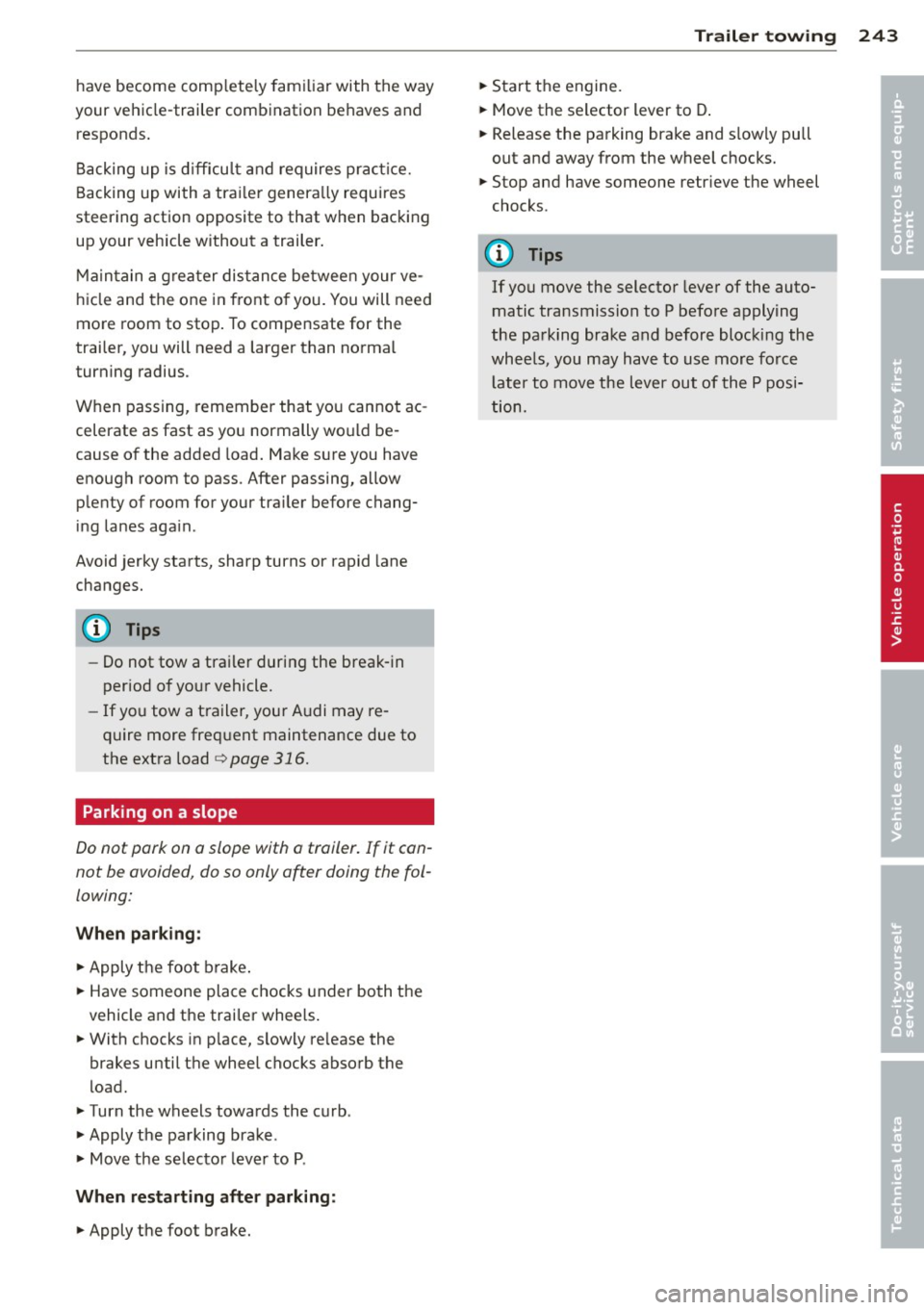
have become completely familiar with the way
your vehicle-trailer combination behaves and responds.
Backing up is difficu lt and requires practice.
Backing up with a trai ler genera lly requires
steering action opposite to that when backing up your vehicle without a trailer .
Maintain a greater distance between your ve
hicle and the one in front of you. You will need
more room to stop . To compensate for the
trai ler, you will need a larger than norma l
turning radius.
When passing, remember that you cannot ac
celerate as fast as you normally would be
cause of the added load . Make sure you have
enough room to pass. After passing, allow plenty of room for your tra iler before chang
ing lanes again .
Avoid jerky starts, sharp turns or rapid lane
changes.
@ Tips
- Do not tow a traile r during the break-in
period of your vehicle.
- If you tow a trailer, your A udi may re
quire more frequent maintenance due to
the extra load
<=> page 316.
Parking on a slope
Do not park on a slope with a trailer. If it can
not be avoided, do so only after doing the fol
lowing:
When parking:
.. Apply the foot brake .
.. Have someone place chocks under both the
vehicle and the trai ler wheels .
.. With chocks in place, slowly re lease the
brakes until the wheel chocks absorb the
load .
.. Turn the wheels towards the curb .
.. Apply the parking brake .
.. Move the selector lever to P.
When restarting after parking:
.. Apply the foot brake.
Trailer towing 243
.. Start the engine.
.. Move the selector lever to D.
.. Release the parking brake and s low ly pull
out and away from the wheel chocks.
.. Stop and have someone retr ieve the wheel
chocks.
(D Tips
If you move the selector lever of the auto
matic transmission to P before applying
the parking brake and before blocking the
whee ls, you may have to use more force
l ater to move the lever out of the
P posi
tion.
•
•
Page 246 of 340
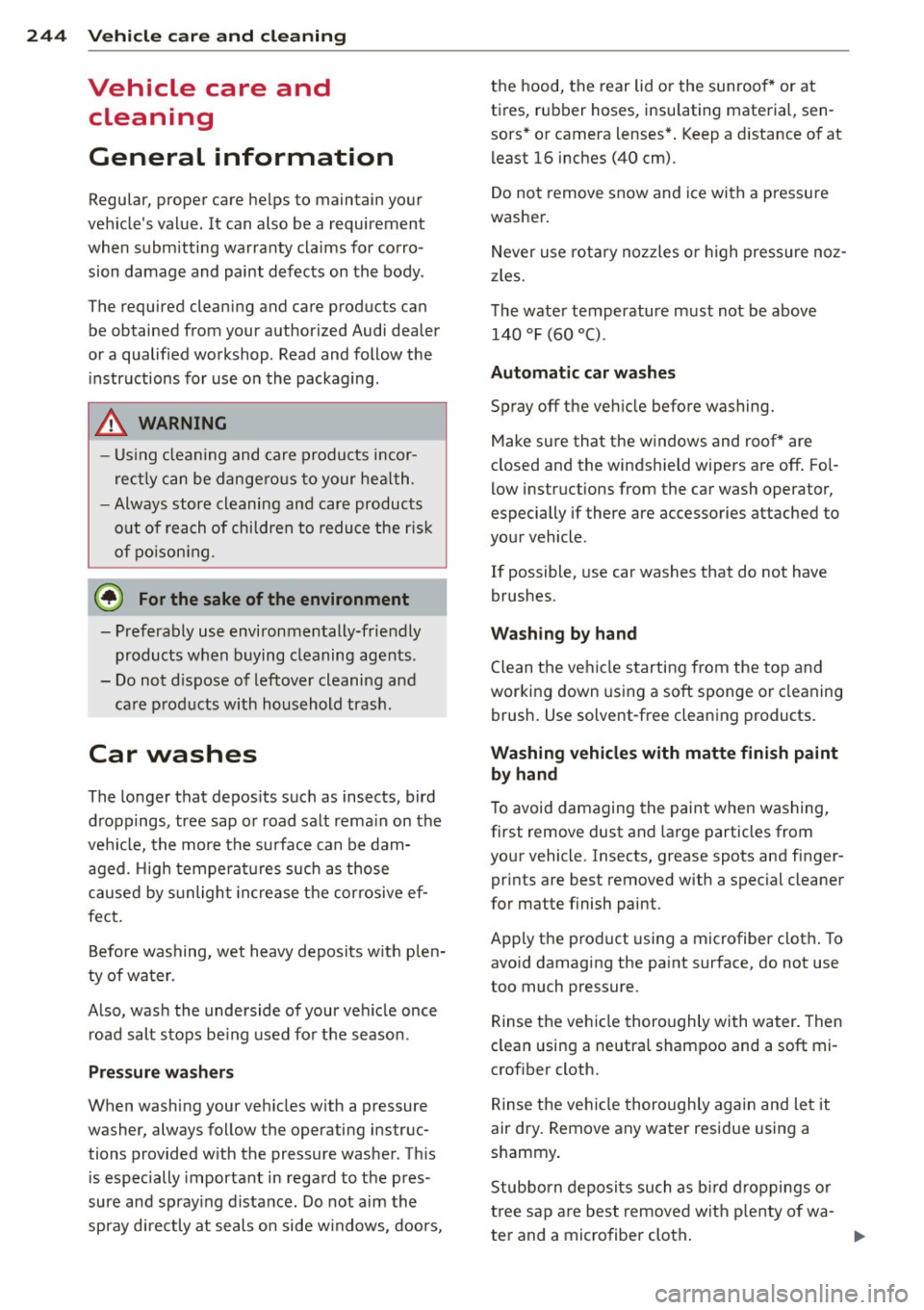
24 4 Vehicle care and cleaning
Vehicle care and
cleaning
General information
Regular, proper care helps to maintain your
vehicle 's value. It can also be a requirement
when subm itting warranty claims for corro
sion damage and paint defects on the body .
The required cleaning and care products can be obtained from your authorized Audi dealer
or a qualified workshop. Read and follow the
instructions for use on the packaging .
A WARNING
-Us ing cleaning and care products incor
rect ly can be dange rous to your hea lth .
- Always store cleaning and care products
o ut of reach of children to reduce the r is k
of po ison ing.
@) For the sake of the environment
- Preferably use environmentally-friendly
products when buying cleaning agents .
- Do not d ispose of leftover cleaning and
ca re p rod ucts with household trash .
Car washes
-
The longer that depos its such as insects, bird
droppings , tree sap o r road salt rema in on the
ve hicle, the more the surface can be dam
aged. High tempera tures such as those
caused by s unligh t increase the corrosive ef
fect.
B efore washing, wet heavy deposits w ith p le n
ty of water.
A lso, wash the underside of your vehicle once
road salt stops be ing used fo r the season .
Pressure wa sher s
When washing your vehicles w ith a pressure
washer, always follow the operating instruc
tions provided w ith the pressure washer. Th is
is especially important in rega rd to the pres
sure and spray ing distance . Do not aim the
spray d irectly at seals o n side w indows, doors, the hood, the
rear lid o r the sunroof * or at
tires, rubber hoses, insu lating material, sen
sors * or camera lenses* . Keep a d istance of at
l east 16 inches (40 cm).
Do not remove snow and ice with a pressu re
washer .
Never use rota ry no zzles or high pressure noz
z les.
T he water temperature must not be above
140
°F (60 °() .
Automatic car washes
Spray off the ve hicle before washing.
Make sure that the windows and roof * are
closed and the winds hield wipers are off . Fo l
l ow instructions from the car wash operator,
especially if there are accessories attached to
your vehicle.
If possible, use car washes that do not have
brushes .
Washing by hand
Clean the ve hicl e starting from the top and
working down using a soft sponge or cleaning
brush . Use solvent-free cleaning products.
Washing vehicles with matte finish paint
by hand
T o avoid damaging the paint when washing,
first remove dust and la rge particles from
your vehicle. Insects, grease spots and finger
prints are best removed with a special cleaner
for matte finish paint .
Apply the prod uct us ing a microfiber cloth . To
avo id damaging the pa int surface, do not use
too much pressure.
Rinse the vehicle thoro ughly with water . Then
clean usi ng a neutral shampoo and a soft mi
crof iber cloth.
Rinse the vehi cle thoroughly again and le t it
air dry . Remove any water residue using a
shammy.
Stubborn deposits su ch as b ir d droppi ngs o r
t ree sap are best remove d with p lenty o f wa -
ter and a microfiber cloth . ..,.
Page 257 of 340
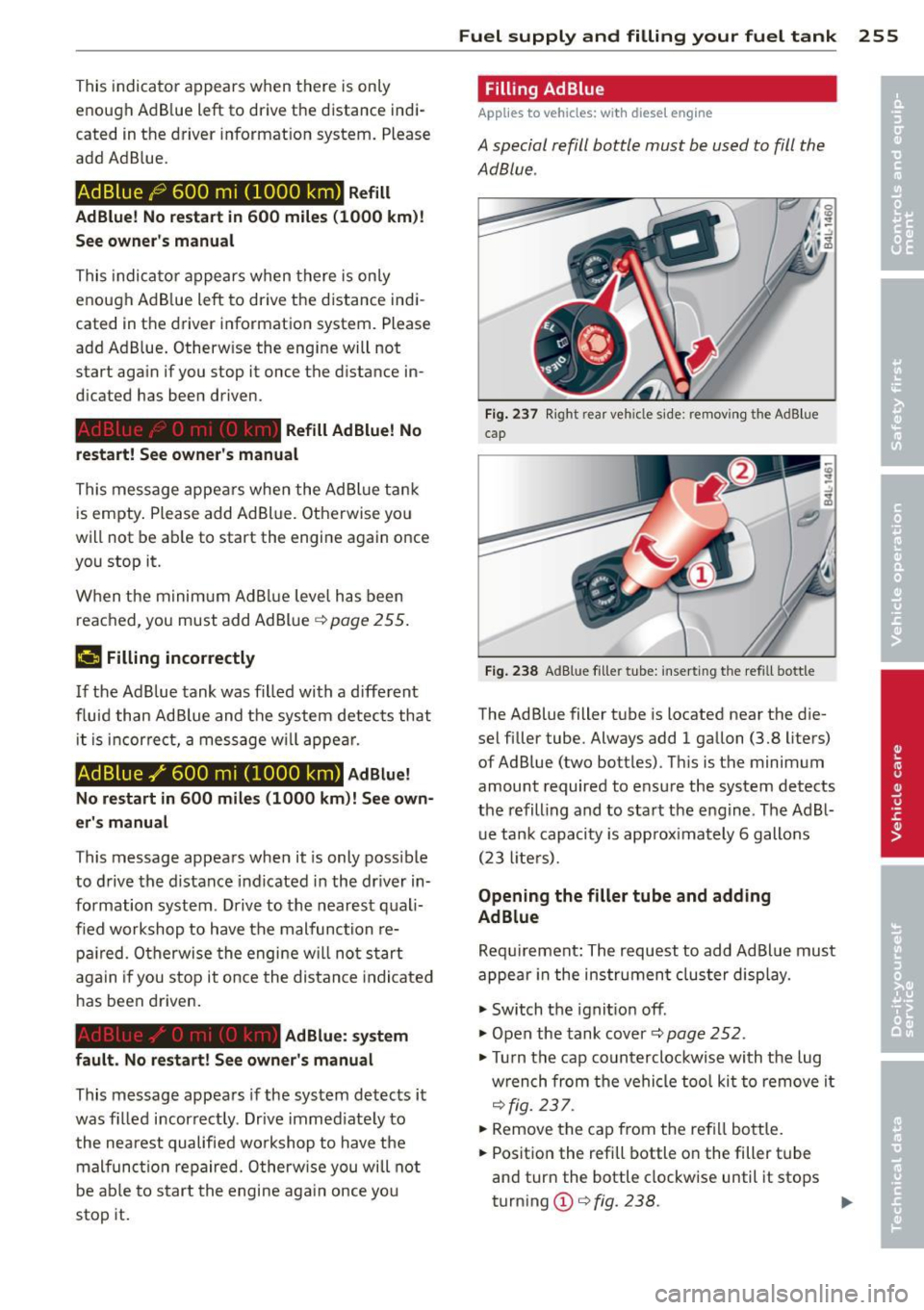
This indicator appears when there is on ly
enough Ad Blue left to drive the distance indi
cated in the driver informat ion system. Please
add Ad B lue.
Ad Blue /9 600 m i (1000 km) Refill
AdBlue! No restart in 600 miles (1000 km )!
See owner's m anual
This indica to r appears when there is on ly
enough Ad Blue left to drive the d istance indi
cated in the driver information system. Please
add Ad B lue . Otherw ise the eng ine will not
start aga in if you stop it once the distance in
dicated has been driven.
Refill AdBlue! No
restart! See owner's manual
This message appea rs when the AdBl ue tan k
is empty . Please add AdBlue. Otherwise yo u
will not be ab le to start the engine again once
you stop it.
When the minim um AdBl ue level has been
reached, you must add Ad Bl ue
q page 255 .
¢'4 Filling incorrectly
If the Ad Blue tank was filled with a diffe rent
f luid than Ad Blue and the system detec ts that
it is i ncor rect, a message w ill appe ar.
AdBlue / 600 mi (1000 km) Ad Blue!
No re start in 600 mile s (1000 km )! See own ·
e r' s manual
This message appea rs when it is only poss ible
to d rive the distance ind icated in the dr iver in
formation system . Drive to the nearest q uali
f ied work shop to have the malfunct ion re
p air ed. Otherwise the engine w ill no t start
again if you stop it o nce the distan ce indi cated
h as been driven.
AdBlue: sy stem
fault . No restart! See owner 's manual
This message appea rs if the system detects it
was fi lled incor rectly . Drive immed iate ly to
t he nea rest qualified wo rkshop to have the
m alf unct io n repaired. Otherw ise you will n ot
be ab le to s tart the engine aga in once yo u
stop it.
Fu el suppl y and filli ng your fuel t ank 255
Filling AdBlue
Applies to vehicles: with diese l engine
A special refill bottle must be used to fill the
AdBlue .
Fig. 23 7 Right rear vehicle side: removing t he AdB lue
cap
Fi g. 23 8 Ad B lue fill er tube: inserting th e refill bottle
The Ad Blue filler tube is located near the d ie
sel filler tube. Always add 1 gallon (3.8 liters)
of Ad Blue (two bott les). T his is the minimum
amount required to ens ure the system detects
the refill ing and to sta rt the e ng ine. The Ad B l
u e tank capacity is app rox imately 6 gallons
( 2 3 lite rs).
Opening the filler tube and adding
Ad Blue
Req uirement: The request to add Ad Blue must
appear in the instrumen t cluster disp lay. •
.,. Switch the ignit ion off .
.,. Open the tank cover
q pag e 2 52.
.. Tu rn the cap co untercloc kwise with the lug
w ren ch from the vehicle too l ki t t o rem ove it
qfig. 237.
.. Remove the ca p from the refi ll bott le.
.. Position the refill bottle o n the filler tube
and turn the bottle clockwise until it stops
turn ing
(D q fig. 238. 1111>
Page 258 of 340
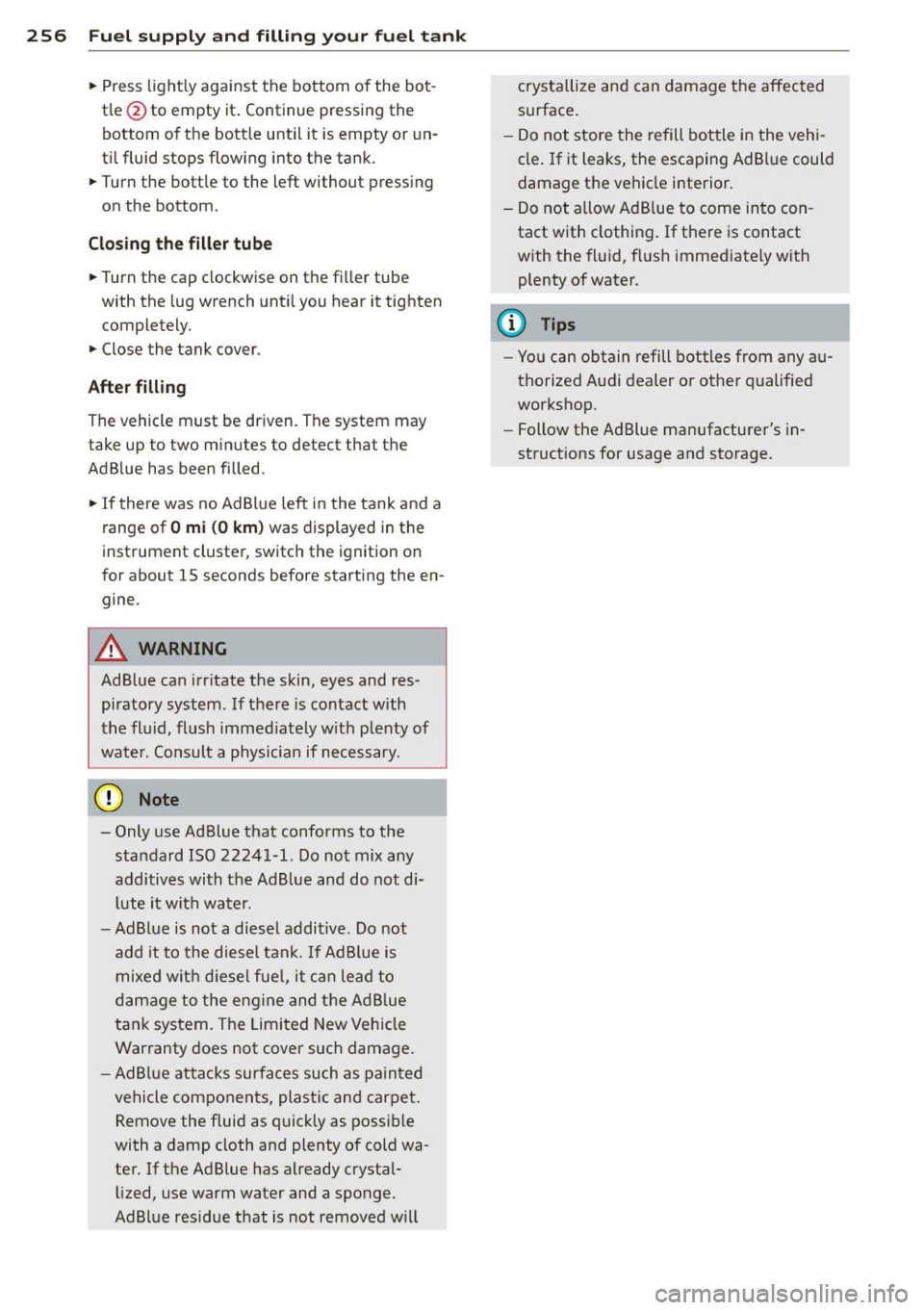
256 Fuel supply and filling your fuel tank
• Press lightly against the bottom of the bot
tle @to empty it. Continue pressing the
bottom of the bottle until it is empty or un
til fluid stops flowing into the tank.
• Turn the bottle to the left without pressing
on the bottom .
Closing the filler tube
• Turn the cap clockwise on the filler tube
with the lug wrench until you hear it tighten
completely.
• Close the tank cover.
After filling
The vehicle must be driven. The system may
take up to two minutes to detect that the
Ad Blue has been filled.
• If there was no Ad Blue left in the tank and a
range of
O mi (0 km) was displayed in the
instrument cluster , switch the ignition on
for about 15 seconds before starting the en
gine.
A WARNING
, -
AdBlue can irritate the skin, eyes and res-
piratory system. If there is contact with
the fluid, flush immediately with plenty of
water. Consult a physician if necessary.
Q) Note
- Only use Ad Blue that conforms to the
standard ISO 22241-1. Do not mix any
additives with the Ad Blue and do not di lute it with water.
-AdBlue is not a diesel additive . Do not
add it to the diesel tank. If Ad Blue is
mixed with diesel fuel, it can lead to
damage to the engine and the Ad Blue
tank system. The Limited New Vehicle
Warranty does not cover such damage.
- Ad Blue attacks surfaces such as painted
vehicle components, plastic and carpet. Remove the fluid as quickly as possible
with a damp cloth and plenty of cold wa
ter. If the Ad Blue has already crystal lized, use warm water and a sponge.
AdBlue residue that is not removed will crystallize and can damage the affected
surface.
- Do not store the refill bottle in the vehi
cle. If it leaks, the escaping Ad Blue could
damage the vehicle interior.
- Do not allow Ad Blue to come into con
tact with clothing. If there is contact
with the fluid, flush immediately with
plenty of water.
(D Tips
- You can obtain refill bottles from any au
thorized Audi dealer or other qualified
workshop .
- Follow the Ad Blue manufacturer's in
structions for usage and storage.
Page 263 of 340
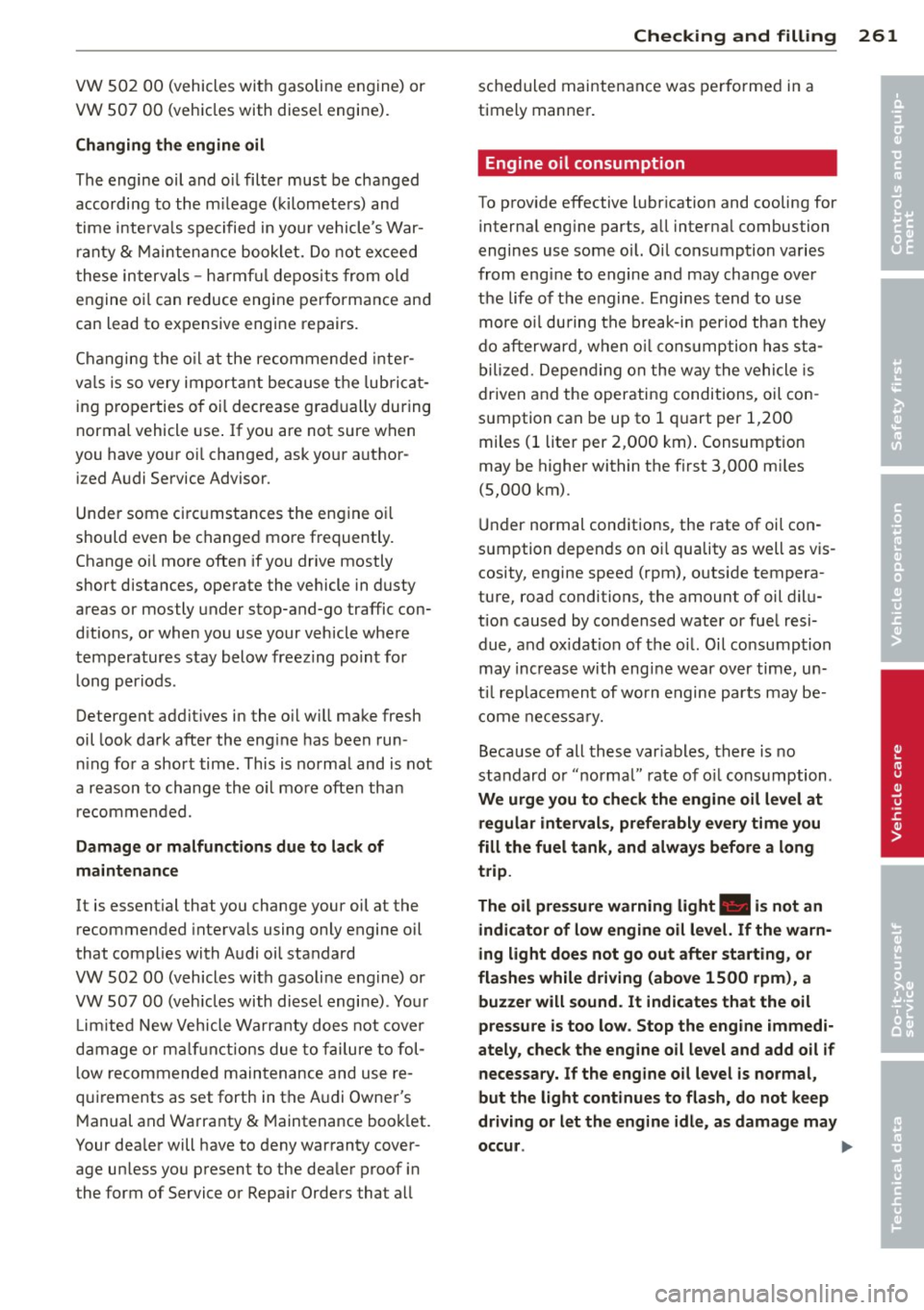
VW 502 00 (vehicles with gasoline engine) or
VW
507 00 (vehicles with diesel engine).
C han gin g the en gin e o il
The engine oil and oil filter must be changed
according to the m ileage (ki lomete rs) and
time inte rva ls specified in your vehicle 's War
r anty
& M aintenance booklet. Do not ex ceed
t hese intervals -harmf ul depos its from old
engine oi l can reduce engine performance and
can lead to expensive engine repairs.
Changing the o il at the recommended inte r
va ls is so very important because the lub ric at
ing p roperties o f oi l decrease grad ually during
norma l vehicle use . If you are not sure when
you have yo ur oi l changed, ask your a uthor
ized A udi Service Advisor.
Unde r some ci rc u mstances the engine o il
should even be changed more frequently.
Change o il more often if you drive mostly
short distances, operate the vehicle in dusty
areas or mostly under stop-and-go traffic con
d itions, or when you use your vehicle where
temperatures stay below freezing po int for
l ong periods .
Detergent addit ives in the o il w ill make fresh
oil look dark after the eng ine has been run
ni ng fo r a short time . This is no rmal and is not
a reason to change the o il mo re often than
r ec om mended.
Damage or malfun ctions due to lack of
maintenance
It is essential that yo u change your oil at the
recommended interva ls using only engine oil
that complies with Audi oi l standard
VW
502 00 (vehicles with gasoli ne engine) or
VW
507 00 (veh icles with diesel engine) . You r
Lim ited New Vehicle Wa rra nty does not cove r
damage or m alfu nct ions due to f ailure to fol
l ow recommended maintenance and use re
q uir ements as set forth in the A udi Owner's
M anual and Warranty
& M aintenance book let.
Your dea ler will have to deny warranty cover
age un less you present to the dea ler proof in
the form of Service or Repa ir Orders that all
Checkin g and fillin g 261
scheduled maintenance was performed in a
timely manner.
· Engine oil consumption
To provide effective l ubr ication and cooling for
interna l eng ine parts, all interna l combustion
engines use some oi l. Oi l consumption varies
from eng ine to engine and may change over
the life of the engine . Engines tend to use
more o il du ring the b reak-in period tha n they
do afterward, when o il cons umption has sta
bilized. Depend ing on the way the vehicle is
driven and the operating conditions, oil con
s u mption can be up to
1 quart per 1,200
miles (l liter per 2,000 km) . Consumption
may be higher within the first
3,000 m iles
(5,000 km) .
U nder normal conditions , the rate of oi l con
s u mption depends on oi l quality as well as vis
cosity, engine speed (rpm), outs ide tempera
ture, road conditions, the amount of oil dilu
tion caused by condensed water or fue l resi
due, and ox idat ion of the o il. Oi l consumption
may increas e with eng ine wear over time, un
t il rep lacement of worn engine pa rts may be
come ne cessa ry.
Because of all these var iables, there is no
standard o r "n orma l" rate of o il cons umption .
We urge you to check the engine oil level at
regular interval s, preferably every time y ou
fill the fuel t ank, and always before a long
trip .
The oil pres sure warning light. i s not an
indicator of low engine oil level. If the warn
ing light does not go out after starting, or
flashes while dr iving (above 1500 rpm), a
buzzer will sound. It indicate s that the oil
pressure is too low . Stop the engine immedi
ately , check the engine oil level and add oil if
necessa ry. If the engine oil level is normal,
but the l ight continues to fla sh, do not keep
driving or let the engine idle, as damage may
occur .
IIJ,
•
•
Page 282 of 340
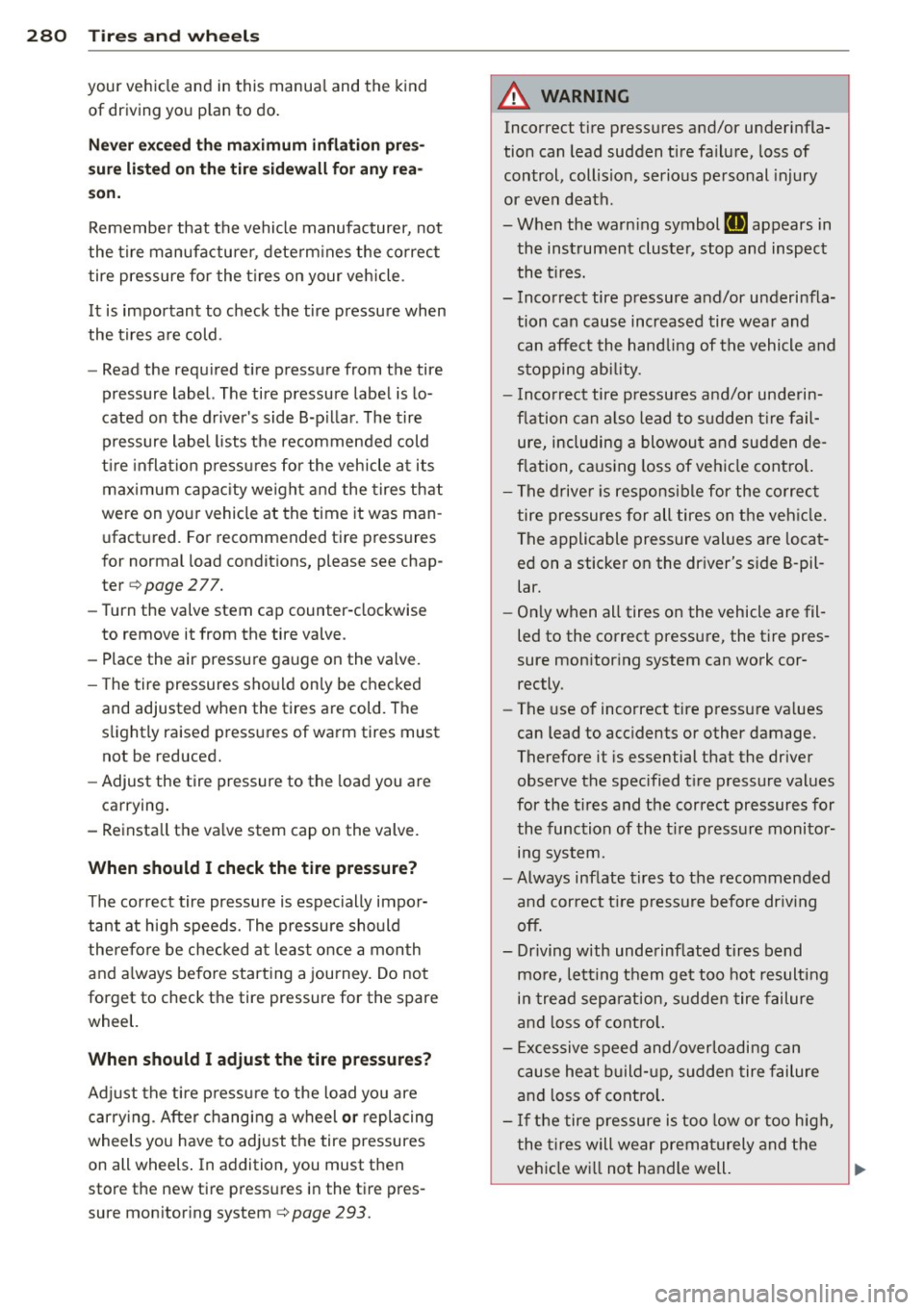
28 0 T ire s and wheel s
your veh icle and in this manua l and the kind
of driving yo u plan to do .
Neve r e xcee d the m ax imum inflati on pres
s u re list e d on th e tir e s ide wall f or a ny r ea
s on.
Remember that the vehicle manufacturer, not
the tire manufacturer , determ ines the co rrect
tire pressure for the t ires on your veh icle .
It is important to check the tire pressure when
the tires a re cold .
- Read the required t ire pres sure from the tire
pressure label. The ti re pressure label is lo
cated on the driver's side 8-p illar . The t ire
pressure label lists the recommended cold
t ire inflat ion p ressu res for the veh icle at its
maximum capacity we ight and the tires that
were on you r vehicle at the time it was man
ufactured . For recommended tire pressures
for normal load condit ions, please see chap
ter
c:> page 2 77.
- Turn the valve stem cap counter-clockwise
to remove it from the tire valve.
- Place the a ir pressure gauge on the valve.
- T he tire pressures should on ly be checked
and adjusted when the tires are cold. The
s li ghtly raised pressures of warm tires must
not be reduced.
- Adjust the tire pressure to the load you are
carrying .
- Reinsta ll the va lve stem cap on the valve.
When should I check the tire pressur e?
The correct tire pressure is especially impor
tant at high speeds. The pressure should
therefore be checked at least once a month
and always befo re starting a journey. Do not
forget to check the tire pressure for the spare wheel.
When should I ad ju st th e tire p re ss ures?
Adj ust the tire p ressure to the load you are
carry ing . After chang ing a wheel
or replacing
wheels you have to adjust the tire pressures
on all wheels . In addition, you must then
store the new tire press ures in the tir e pres
sure monito ring system
c:> page 293.
A WARNING
Incorrect tire pressures and/or underinfla
tion can lead sudden tire fa ilure, loss of
control, collision, serious personal injury
or even death .
- When the warn ing symbol
[I] appears in
the instrument cluster, stop and inspect
the t ires.
- Incorrect tire pressure and/or underinfla
tion can cause increased tire wear and
can affect the hand ling of the vehicle and
stopping abi lity.
- I nco rrect tire pressures a nd/or underin
f lation can a lso lead to sudden t ire fail
ure, including a blowout and sudden de
flation, ca using loss of vehicle contro l.
- The drive r is responsible for the correc t
tire pressures for all tires on the veh icle.
The applicable pressure values are locat
ed on a sticker on the driver's side B -pil
lar.
- On ly when all tires on the vehicle are fil
led to the correct pressure, the tire pres
sure mon itoring system can work cor
rectly.
- The use of incorrect tire pressure va lues
can lead to acc idents or other damage.
Therefore it is essential that the driver
observe the spec ified t ire pressure values
for the tires and the correct pressures for
the function of the t i re press ure monitor
ing system.
- Always inflate t ires to the recommended
and correct t ire p ressure before dr iv ing
off.
- Driving with underinf lated tires bend
mo re, letting them get too hot resulting
in tread sepa ration, s udde n tire failure
and loss of cont ro l.
- E xcessive speed and/overloadi ng can
cause heat b uild- up, sudden tire failure
and loss of cont ro l.
- I f the tire pressure is too low or too high,
the t ires will wear prema turely and the
vehicle wi ll not handle well. ..,
Page 326 of 340
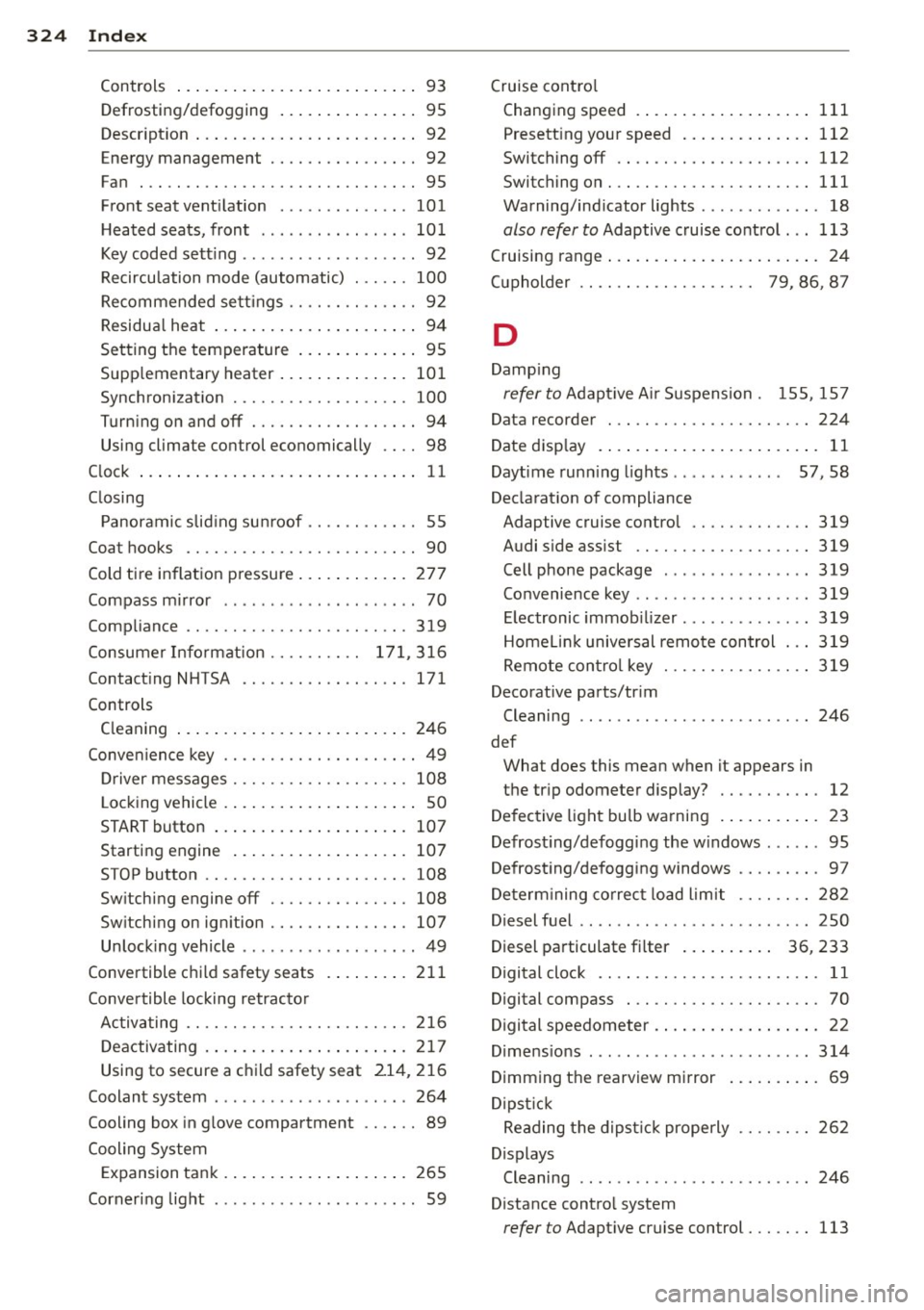
324 Index
Controls .... .. .. ..... ... .. .. .... .. 93
Defrosting/defogging . . . . . . . . . . . . . . . 95
Descr ipt ion .. .. ... .... ... .. .. .... .. 92
Energy management . . . . . . . . . . . . . . . . 92
Fan . .. .. .... ........... ........ .. 95
Front seat ventilation ...... ... .. ... 101
H eated seats, front ....... .. .. .. .. . 10 1
Key coded sett ing .............. ..... 92
Recircu lation mode (automatic) ... ... 100
Recommended se ttings .............. 92
Residua l heat ... ...... ... .. .. .... .. 94
Setting the temperature ... .. .. .... . . 95
Supp lementary heater ... .. .. ... ... . 101
Synchron izat ion ............ .. .... . 100
Turn ing on and off ........ .. .. .... .. 94
Using climate control economically . . . . 98
C lock ... .... ... . ...... ... .. .. .... .. 11
C losing
P anoramic slid ing su nroof .. .. .. .. .. . . 55
Coat hooks . . . . . . . . . . . . . . . . . . . . . . . . . 90
Cold ti re inflat ion p ressure ... .. .. .... . 27 7
Compass m irror ..... ...... .. .. .. .. .. 70
Comp liance .. ............. .. .. .. ... 319
Consumer Info rmation . . . . . . . . . . 1 71, 3 16
Contact ing NHTSA ...... .... ... .... . 171
Controls Cleaning ... ... .. ..... ... .. .. .... . 246
Conve nience key ..................... 49
Dr iver messages ........ .. .. .. .. .. . 108
L ock ing vehicle ... ..... ... .. .. .... .. 50
START button .. .. ..... ... .. .. .... . 10 7
Starting engine ....... ... .. .. .... . 107
STOP button ...................... 108
Sw itching engine off ............... 108
Sw itching on ignition .. ..... ..... .. . 107
Unlock ing vehicle .......... ... .. .... 49
Convertible c hil d safety seats . ... .. .. . 211
Conve rtible locking retracto r
Activating ........................ 216
Deactivating . . . . . . . . . . . . . . . . . . . . . . 217
Using to secure a chi ld safety seat 21 4, 2 16
Coolant system ................. .... 264
Cooling box in g love compartment .. .... 89
Cooling System Expansion tank . .. ..... ... .. .. .... . 265
Corner ing light .. .... ...... .. .. .. .. .. 59 Cruise cont
ro l
Changing speed .. .. ... ..... ... .. .. 111
Presett ing your speed .. ..... ... .. .. 112
Switching off ..................... 112
Switching on ..... ............. .... 111
Warning/ind icator lights ........... .. 18
also refer to Adaptive cruise control ... 113
Cruising range . . . . . . . . . . . . . . . . . . . . . . . 24
(upholder . . . . . . . . . . . . . . . . . . . 79 , 86, 8 7
D
Damp ing
refer to Adapt ive A ir Suspension . 155, 15 7
Data recorder ... .. ............. .. .. 224
Date d is p lay . . . . . . . . . . . . . . . . . . . . . . . . 11
Daytime run ning l ights... ....... .. 57, 58
Declarat ion of compliance
Adaptive cruise control ............. 319
Audi side ass ist ................... 319
Cell phone package . . . . . . . . . . . . . . . . 319
Convenience key .. .. ... ....... ... .. 319
E lectronic i mmob i Lizer . . . . . . . . . . . . . . 319
Homel in k universal remo te control ... 319
Remote contro l key ............ .... 319
Decorative parts/tr im
Cleaning ...... .................. . 246
def What does this mean when it appears in
the tr ip odometer display? ........... 12
De fective light bu lb warning . ... .. .. .. . 23
Defrost ing/defogg ing the w indows ... .. . 95
Defrost ing/defogging windows ......... 97
De term ining co rrect load limit ........ 282
Diesel fuel .. .. .. .. .. ... ....... ... .. 250
Diesel pa rticulate f ilter . . . . . . . . . . 36, 233
Digital cloc k . . . . . . . . . . . . . . . . . . . . . . . . 11
Digital compass . . . . . . . . . . . . . . . . . . . . . 70
Digital speedometer . . . . . . . . . . . . . . . . . . 22
Dime nsio ns .. ... ................... 314
Dimming the rearview mirror ... .. .. .. . 69
D ipst ick
Reading the d ipst ic k properly ........ 262
Displays Cleaning . . . . . . . . . . . . . . . . . . . . . . . . . 246
Distance control system
refer to Adapt ive cruise control ..... .. 113
Page 327 of 340
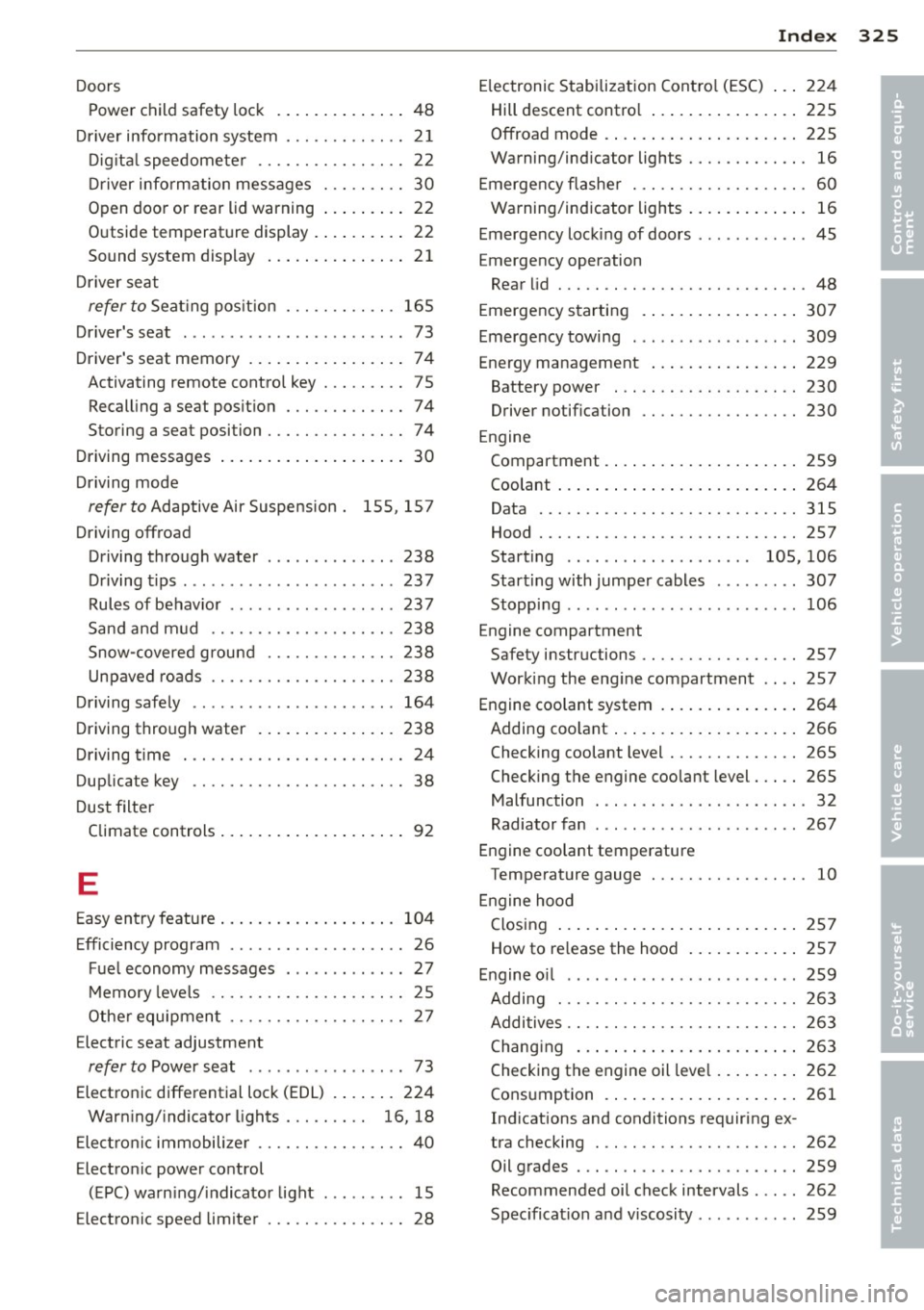
Doors
Power child saf ety lock . ... .. .. .. .. ..
48
Dr iver information system ... .. .. .. .. .. 2 1
Di gita l speedomete r ...... .. .. .. .. .. 22
D river info rmation messages . . . . . . . . . 30
Open door or rear lid warning . . . . . . . . . 22
Outside temperature display . ... .. .. .. 22
Sound system display .. ... .. .. .. .. .. 2 1
D river seat
refer to Seat ing pos it ion ... .. .. .. .. . 165
Driver's seat . . . . . . . . . . . . . . . . . . . . . . . . 73
Driver's seat memory . . . . . . . . . . . . . . . . . 7 4
Activating remote control key . .. .. .. ..
75
Recall ing a seat posit ion . . . . . . . . . . . . . 7 4
Sto ring a seat position . . . . . . . . . . . . . . . 7 4
D riving messages . . . . . . . . . . . . . . . . . . . . 30
Driving mode
refer to Adaptive Air Suspe nsion . 155, 1 57
Driving offroad
Driving through water ......... ... .. 238
Driving tips .... ........... ... ... ..
237
Rule s of behav io r ............ .. .... 23 7
S and and m ud ........... .... .. .. . 238
Snow-covered groun d ..... .. .. .. .. .
238
Unpaved roads ........... .... .. ... 238
Dr iving safe ly .......... ...... .... ..
164
Driving through water ... ... .. .. .. .. . 238
D riving t ime . . . . . . . . . . . . . . . . . . . . . . . .
24
Duplicate key . . . . . . . . . . . . . . . . . . . . . . . 38
D ust filter
Climate controls . . . . . . . . . . . . . . . . . . . .
92
E
E asy en try featu re .. ..... ... .. .. .. .. . 104
Efficiency program . . . . . . . . . . . . . . . . . . . 26
Fue l economy messages . ...... ... ... 27
M emory levels . . . . . . . . . . . . . . . . . . . . . 25
Othe r equipmen t ......... .. .. .. .. .. 2 7
Electric seat adjustment
refer to Power seat . . . . . . . . . . . . . . . . . 73
Electro nic differential lock (EDL) . ... .. . 224
Warn ing/ indicator lights . . . . . . . . . 16, 18
Ele ctr onic immobili ze r ...... .. .. .. .. .. 40
Electronic power co ntrol
( E PC) wa rn ing/indicator light ... ... ...
15
Electronic speed limiter . . . . . . . . . . . . . . . 28
Inde x 325
Electronic Stabilization Cont ro l (E SC) ... 224
Hill descent contro l ..... .... ... .. .. 225 •
Offroad mode .. .. .. . .. ... .... ... .. 225 •
Warning/ind icator lights .......... .. . 16
Emerge ncy flashe r . . . . . . . . . . . . . . . . . . . 60
Wa rning/ind icator lights ..... ... .. .. . 16
Emergency locking of doors ............ 45
Emergency operation
Rear lid . .. .. .. .. .. ............... .
48
Emergency starting . .. .. ..... ... .. .. 3 0 7
Emerge ncy towing ... . .. .. .. ... ... .. 309
Energy management ... .. .... ... .. .. 229
Battery power . .. .... ........... .. 230
Driver notification ................. 230
Engine
Compartment .... .. . .. .. ..... ... ..
259
Coolant ... .. .... .. . .. .. ..... ... .. 264
Data ..... .. .. .. ... ............ .. 315
Hood ..... .. .. .. ................. 257
Start ing . . . . . . . . . . . . . . . . . . . . 105, 106
Starting with jumpe r cables ........ . 307
Stopping ........ .. ............... 106
Engine compartment
Safety instr uctions .. ........... .... 257
Work ing the eng ine compartment .. ..
257
Engine coolant system . .. ..... ... .. .. 264
Adding coo lant ..... . .. .. ..... ... .. 266
Checking coolant level .............. 265
Checking the engine coolant level ... .. 265
Malfunction . . . . . . . . . . . . . . . . . . . . . . . 32
Radiator fan ..... .. ............... 267
Engine coolant temperature
Temperat ure gauge ............ .... .
10
Engine hood
Closing ... .. .... .. . .. .. ..... ... ..
2 57
How to re lease the hood ..... ... .. .. 257
Engine o il ..... ... .. ............... 259
Adding ... .. .. .. ............... .. 263
Addi tives .... .. ...... ........... ..
2 63
Changi ng ... .. .... .. ... ..... ... .. 263
Checking the engine oil leve l .. ... .. ..
262
Consumption . ..... . .. .. ..... ... .. 261
Ind ications and conditions requir ing ex-
tra checking . .. .. ............... ..
262
Oil grades . .. .. .. ................. 259
Recommended oil check intervals . .. .. 262
Spec ificat io n and viscosity .......... . 259